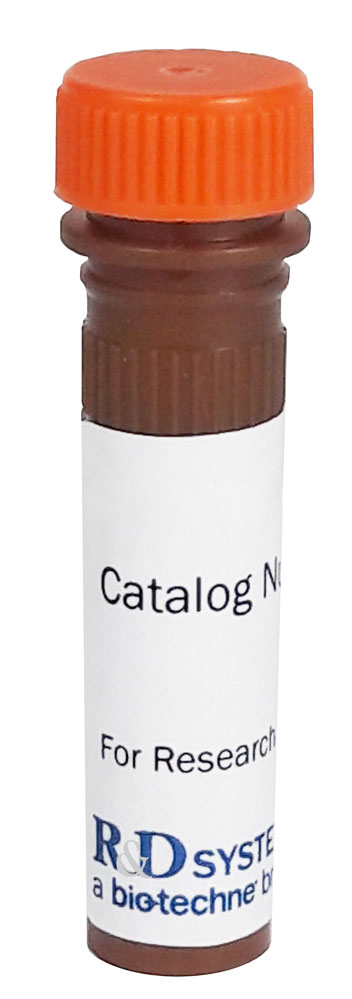Human CD229/SLAMF3 Alexa Fluor® 594-conjugated Antibody Summary
Lys48-Lys454
Accession # Q9HBG7
Applications
Please Note: Optimal dilutions should be determined by each laboratory for each application. General Protocols are available in the Technical Information section on our website.
Reconstitution Calculator
Preparation and Storage
Background: CD229/SLAMF3
CD229, also known as Ly9 and SLAMF3, is a 120 kDa type I transmembrane glycoprotein in the SLAM subgroup of the CD2 family (1). Mature human CD229 consists of a 407 amino acid (aa) extracellular domain (ECD) with two Ig‑like V-set and two Ig‑like truncated C2-set domains. It also shows a 22 aa transmembrane segment, and a 179 aa cytoplasmic domain with two immunoreceptor tyrosine-based switch motifs ITSMs (2, 3). The ECD of human CD229 shares 57%‑59% aa sequence identity with mouse and rat CD229. Within the first two Ig‑like domains that are common to all SLAM proteins, human CD229 shares 24%‑39% aa sequence identity with human 2B4, BLAME, CD2F-10, CD84, CRACC, NTB-A, and SLAM. Alternate splicing generates two additional isoforms that lack the juxtamembrane Ig‑like domain or short cytoplasmic region (2). CD229 is expressed on T and B cells, thymocytes, and more weakly on NK cells (2‑6). Homophilic binding between CD229 molecules is mediated by the N-terminal Ig‑like domain (7). Human and mouse CD229 exhibit cross-species binding (7). Antigen stimulation of lymphocytes induces CD229 clustering to sites of T cell‑B cell contact (7). Two tyrosines in the cytoplasmic domain are required for association of CD229 with the adaptor proteins AP-2 (μ2 chain) and GRB-2 and both are required for CD229 internalization (8, 9). In addition, there are two ITSMs which mediate phosphorylation-dependent CD229 association with SAP and SHP-2 (10). These four tyrosine-containing motifs are intact in the described CD229 splice variants. CD229 knockout mice show minimally impaired immune responses, suggesting functional redundancy with other molecules (11).
- Bhat, R. et al. (2006) J. Leukoc. Biol. 79:417.
- de la Fuente, M.A. et al. (2001) Blood 97:3513.
- Sandrin, M.S. et al. (1992) J. Immunol. 149:1636.
- Romero, X. et al. (2004) Tissue Antigens 64:132.
- Hogarth, P.M. et al. (1980) Immunogenetics 11:65.
- Mathieson, B.J. et al. (1980) J. Immunol. 125:2127.
- Romero, X. et al. (2005) J. Immunol. 174:7033.
- Del Valle, J.M. et al. (2003) J. Biol. Chem. 278:17430.
- Martin, M. et al. (2005) J. Immunol. 174:5977.
- Sayos, J. et al. (2001) Blood 97:3867.
- Graham, D.B. et al. (2006) J. Immunol. 176:291.
Product Datasheets
Product Specific Notices
This product is provided under an agreement between Life Technologies Corporation and R&D Systems, Inc, and the manufacture, use, sale or import of this product is subject to one or more US patents and corresponding non-US equivalents, owned by Life Technologies Corporation and its affiliates. The purchase of this product conveys to the buyer the non-transferable right to use the purchased amount of the product and components of the product only in research conducted by the buyer (whether the buyer is an academic or for-profit entity). The sale of this product is expressly conditioned on the buyer not using the product or its components (1) in manufacturing; (2) to provide a service, information, or data to an unaffiliated third party for payment; (3) for therapeutic, diagnostic or prophylactic purposes; (4) to resell, sell, or otherwise transfer this product or its components to any third party, or for any other commercial purpose. Life Technologies Corporation will not assert a claim against the buyer of the infringement of the above patents based on the manufacture, use or sale of a commercial product developed in research by the buyer in which this product or its components was employed, provided that neither this product nor any of its components was used in the manufacture of such product. For information on purchasing a license to this product for purposes other than research, contact Life Technologies Corporation, Cell Analysis Business Unit, Business Development, 29851 Willow Creek Road, Eugene, OR 97402, Tel: (541) 465-8300. Fax: (541) 335-0354.
FAQs
No product specific FAQs exist for this product, however you may
View all Antibody FAQsReviews for Human CD229/SLAMF3 Alexa Fluor® 594-conjugated Antibody
There are currently no reviews for this product. Be the first to review Human CD229/SLAMF3 Alexa Fluor® 594-conjugated Antibody and earn rewards!
Have you used Human CD229/SLAMF3 Alexa Fluor® 594-conjugated Antibody?
Submit a review and receive an Amazon gift card.
$25/€18/£15/$25CAN/¥75 Yuan/¥1250 Yen for a review with an image
$10/€7/£6/$10 CAD/¥70 Yuan/¥1110 Yen for a review without an image



